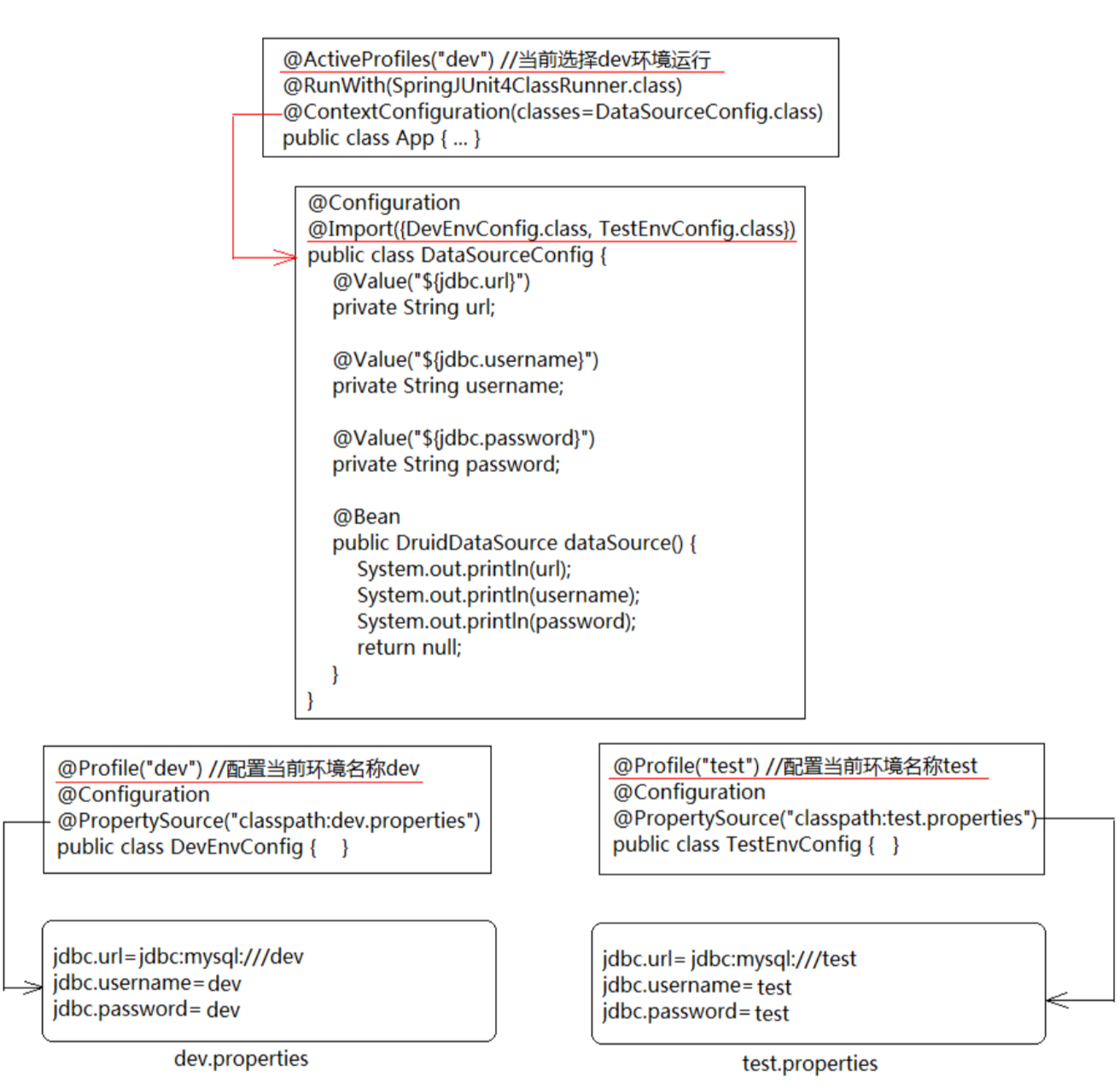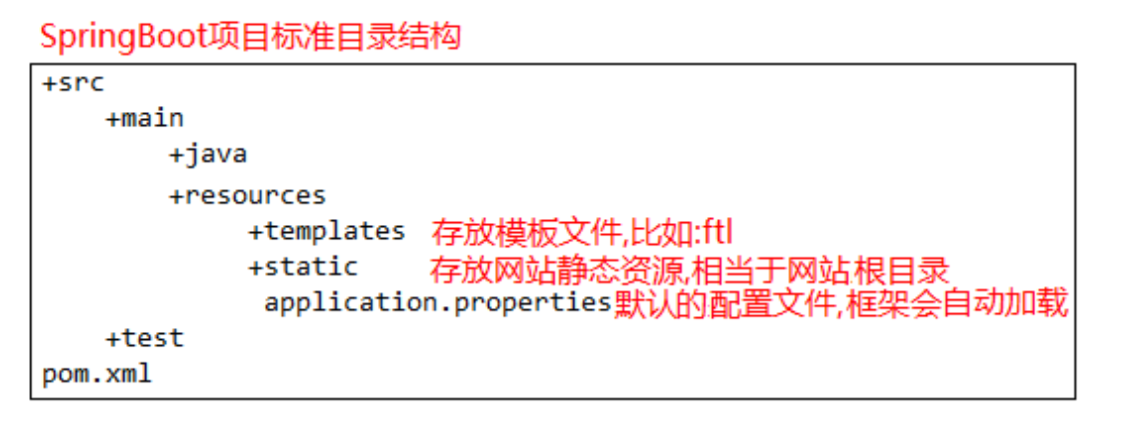Spring Boot
概述:
设计目的是用来简化新Spring应用的初始搭建以及开发过程. 该框架使用了特定的方式来进行配置, 从而使开发人员不再需要定义样板化的配置.
AnnotationConfig配置IoC:
定义:
使用注解彻底替代XML文件,把Bean定义到Java配置类中.
| 注解 | 作用 |
|---|---|
| @Configuration | 贴在配置类上,声明该类为Spring配置类 |
| @Bean | 贴在配置类的方法上,该方法的返回对象交给Spring容器管理 |
| @ComponentScan | 贴在配置类上,开启组件扫描器,默认扫描当前配置类所在的包,可指定包 |
AnnotationConfigApplicationContext: 该类是ApplicationContext接口的实现类,该对象是基于AnnotationConfig的方式来运作的Spring容器
注解方式声明自己定义的配置类
| 注解 | 作用 |
|---|---|
| @Configuration | 表示该类是Spring的配置类 |
| @ComponentScan | 开启组件扫描器,默认扫描当前类所在的包,及其子包 |
当扫描的包不是当前类所在的包时,可以通过注解中的value属性来修改扫描的包.
组件扫描的方式只能扫描我们自己写的组件,如果某个bean不是我们自己写的,例如:连接池.则还是要通过在配置类中定义方法来处理,两者是可以同时存在的.
SpringTest方式加载配置类
@RunWith(SpringJUnit4ClassRunner.class)
@ContextConfiguration(classes={配置类1.class, 配置类2.class, …}):配置classes属性来指定哪些类是配置类
Bean标签
在@bean标签中id,name,init-method,destroy-method,scope等属性来完成对应的配置.
@Bean注解中的属性
| 属性名 | 作用 |
|---|---|
| @name | 用于给name取别名 |
| @initMethod | 配置bean的初始化方法 |
| @destroyMethod | 配置bean的销毁方法 |
| @Scope | 属性名prototype,配置多例,默认是单例 |
AnnotationConfig方式配置DI:
前提:
先要把贴@bean,把bean交给Spring管理,然后在把bean注入过去,再使用setter方法设置关系.
把需要注入的Bean对象作为参数传入到另一个Bean的方法声明中,形参名称最好跟Bean的id一致
1 | //在声明SomeBean的方法形参中直接注入OtherBean对象 |
配置文件导入
在Spring项目中,用到多个配置文件,分别配置不同的组件.最后关联到主配置文件中
使用注解@Import
1 | //主配置类 |
在主配置类中关联XML配置
使用注解@ImportResource
1 | //主配置类 |
导入属性文件
使用注解@PropertySource + @Value
1 | /** |
或者直接在配置类中注入Spring的环境对象
1 | /** |
1 | dataSource.setUrl(environment.getProperty("jdbc.url")); |
切换运行环境

Spring Boot 的web
对于Spring Boot项目来说无论是普通应用还是web应用打包方式都是jar包即可,web也可以打成war包.但是需要额外添加其他插件,比较麻烦.
| 模块 | 作用 |
|---|---|
| spring-boot-starter-parent | 管理和导入基础依赖 |
| spring-boot-starter-web | 集成了web应用所需的环境和工具 |
| @SpringBootApplication | 三大注解功能的集成 |
| SpringApplication.run(..) | 启动SpringBoot应用,加载自定义的配置类,启动嵌入的Tomcat服务器 |
@SpringBootApplication三大注解功能
- @ComponentScan: 开启组件扫描
- @SpringBootConfiguration: 作用等同于@Configuration注解,也是用于标记配置类
- @EnableAutoConfiguration: 加载jar包中META-INF/spring.factories文件中配置的配置对象,自动配
置定义的功能,包括: AOP / PropertyPlaceholder / FreeMarker / HttpMessageConverter / Jackson /
DataSource / DataSourceTransactionManager / DispatcherServlet / WebMvc 等等- AutoConfigurationImportSelector自动配置类中的getCandidateConfigurations方法,加载spring.factories,其中有很多配置对象.
SpringBoot项目的独立运行
需要spring打包插件—>spring-boot-maven-plugin
- 使用maven的package命令进行打包
- 使用命令java -jar xxx.jar运行jar包
spring boot 目录结构

SpringBoot参数配置
application.properties优先级
一个项目中可以有多个application.properties文件存放在不同目录中,此时他们会遵循固定的优先级来处理有冲突的属性配置
- 项目/config/application.properties ——>最高
- 项目/application.properties
- classpath:config/application.properties
- classpath:application.proper ——>最低(常用)
属性绑定
使用@Value绑定单个属性
@ConfigurationProperties绑定对象属性,可以把同类的配置信息自动封装成实体类
1 | //贴在类上 |
或者
1 | //贴在方法上 |
静态资源
Spring Boot默认会从classpath下的/static,/public,/resources,/META-INF/resources寻找静态资源
可以通过修改spring.resources.staticLocations来修改静态资源加载地址
- 文件上传必须去配置文件所在的路径
集成FreeMarker只需添加starter工具包
1 | <!-- SpringBoot集成FreeMarker的依赖 --> |
统一异常处理
自定义一个控制器增强器,专门用于统一异常处理
使用@ControllerAdvice注解: —> 控制器增强器
1 | //控制器增强器 |
集成Druid
1 | <!-- druid --> |
两种配置方式
第一种:配置对象方式
1 | #application.properties |
在java的方法上,使用@ConfigurationProperties注解绑定对象属性.
1 | (initMethod="init", destroyMethod="close") |
第二种:自动配置方式
1 | #application.properties |
集成Mybatis
1 | <!--mybatis集成到SpringBoot中的依赖--> |
1 | #application.properties |
在MyBatis框架使用注解操作数据库
在mapper接口中的抽象方法中贴上各自对应的注解
在属性中写SQL语句
1 | ("插入的SQL语句")//插入 |
查询后需要封装对象使用@Results注解
1 | ({ |
Mapper接口扫描器只要在配置类上贴个注解@MapperScan(…)即可
事务管理
1 | <!-- AOP织入的依赖 --> |
注解方式
在配置类(AppConfig)上贴@EnableTransactionManagement —> 开启事物管理 (2.x)版本以上不需要配置
业务层实现类上或者其方法上直接贴 @Transactional注解 —> 对业务操作做事物管理
SpringBoot默认优先选择CGLIB代理
如果需要改为优先使用JDK代理,则配置spring.aop.proxy-target-class=false #优先使用JDK代理
拦截器
让自定义的拦截器实现WebMvcConfigurer接口,重写addInterceptors方法即可
1 |
|